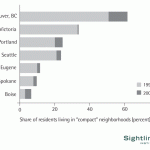Search Results
-
Cascadia Scorecard Update
We just updated our Cascadia Scorecard—and the news ain’t great, my friends. Population: As we reported earlier in the year, the final full-year figures for 2007 fertility trends came in—and the Pacific Northwest is in the middle a modest baby boom. Birthrates were up in every age group, including teens. And there’s some evidence that unintended births are on the rise. Birthrates are the component of population growth over which...Read more » -
Swine Flu In Perspective
Not to belittle anyone’s anxiety about the swine flu, but I’m feeling a little peevish this morning. Today’s newspaper headlines are screaming that the global death toll appears to have surpassed 150, including the first death outside of Mexico. As a consequence, countries are banning imports, setting up travel restrictions, and scrambling public health resources. Everyone’s going code-red. But 150 deaths—the swine flu grand total to date — is just a bad day on the...Read more » -
Our Poisoned Puget Sound
Toxic chemicals plaguing Puget Sound’s fish and orcas, polluted rainwater streaming into the sea, overfishing, damaged shorelines—all of this was my bread-and-butter for news stories during my recently-ended decade at the Seattle P-I. So I was really excited this week to tune into PBS to watch Frontline, a standout of investigative journalism, as it delved into what’s ailing Puget Sound and the Chesapeake Bay in a special called “Poisoned Waters.”...Read more » -
The Green Building Race
I’m loving the spirited competition in green building that seems to be emerging among Northwest cities. Of course, Portland and Seattle have well-established programs, but Northwest cities big and small boast an impressive roster of energy-smart buildings. The latest (and possibly greatest) addition comes from Vancouver, which busted out with a new convention center that is surely one of the all-time grooviest buildings : A sprawling, six acre green roof that’ll be the...Read more » -
Compact Neighborhoods
Low-density sprawl—where houses, jobs, and stores are spread out, and virtually every trip requires a car—remains the norm in Cascadia’s major metropolitan areas. But compact neighborhoods are gradually gaining ground: since 1990, the share of residents living in walkable or transit-oriented neighborhoods has increased in each of the seven largest major Northwest metropolitan areas. Poorly planned, low-density sprawl contributes to a panoply of ills. It confines residents in their cars...Read more » -
But is it Affordable?
Last summer, the Canadian Centre for Policy Alternatives (CCPA) prepared a report to the Vancouver City Council on the city’s EcoDensity Initiative pointing out the initiative’s weakness on affordability. The backers of EcoDensity, a City initiative to make environmental sustainability a primary goal in all city planning decisions, argue that increasing supply by adding density will result in a decrease in housing costs. That follows basic economic principles, but we...Read more » -
Does city living trim greenhouse gas emissions?
The authors of this study, published in The Journal of Urban Planning and Development, quantified the emissions from building materials and construction, home heating and power demands, and transportation energy, in both urban suburban neighborhoods in the Toronto metro area. And they found that downtown residents use radically less energy, and consequently emit about two-thirds less climate-warming CO2 than their suburban counterparts. Take a look: First, they found that the...Read more » -
Communities and Agencies Struggle with Transit Service Cuts
This week, Portland’s Tri Met, the regional transit agency for greater Portland, continues the challenging task of deciding which bus service to cut. Tri Met is faced with a $13.5 million budget short fall, which means it will be forced to reduce service starting in September of 2009, leaving many people in the service area wondering how they will get to work, school and even church. By the same token,...Read more » -
Port Mann Or A Big Tram?
It seems like every major Northwest city has one: a big costly road-expansion project. Seattle has the 520 floating bridge replacement (estimated at maybe $6 billion); Portland has the Columbia River Crossing (pegged at around $4 billion); and Vancouver has the Port Mann Bridge ($3.1 billion). Each city is talking about steep price tags for dubious projects. These are projects that are likely to increase sprawl and driving—and that may...Read more » -
The Danger of Stimulus Done Wrong
Stimulus spending can provide short-term juice to a sputtering economy. But that’s not the same as saying that any old kind of spending is good. Clearly not. It would not be wise, for example, to use deficit spending for vast poppy planations in order to create a domestic heroin trade. And yet, some non-trivial portion of US stimulus spending appears directed at deepening a different kind of hazardous addiction. I’ve taken a...Read more »



